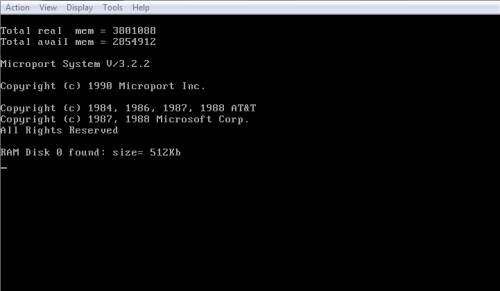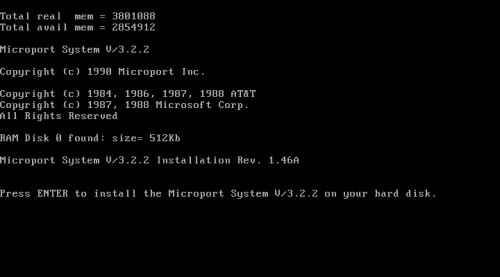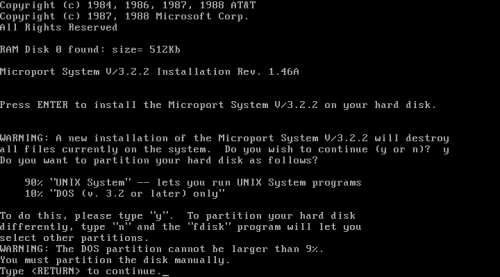Hello, I've found a copy of Microport UNIX 3.2.2. But I cannot get it working in any emulators or VMs. It just hangs at "Booting Microport System V/3.2.2" or causes critical VM error.
ftp://69.43.38.172/mirrors/Unix/Micropo ... 3.2.tar.gz
Microport UNIX 3.2.2
Re: Microport UNIX 3.2.2
Which emulators did you try? If I try to run it in VARCem, for example, it seems to boot just fine:

Although it takes *ages* to get to this state (I waited like 10 minutes or so). I need to check why it is so slow, I suspect something is wrong with my build of VARCem...
Config: Award system with 80386 DX/33 CPU, 4 MB RAM, dual channel IDE controller, 350 MB harddisk, single 1.2mb floppy, Trident VGA, 2x COM, 1x LPT


I stopped at this point to find out why everything is so damn slow, but I suspect it will work just fine...

Although it takes *ages* to get to this state (I waited like 10 minutes or so). I need to check why it is so slow, I suspect something is wrong with my build of VARCem...
Config: Award system with 80386 DX/33 CPU, 4 MB RAM, dual channel IDE controller, 350 MB harddisk, single 1.2mb floppy, Trident VGA, 2x COM, 1x LPT


I stopped at this point to find out why everything is so damn slow, but I suspect it will work just fine...
I upload stuff to archive.org from time to time. See here for everything that doesn't fit BA
- SoftPCMuseum
- Posts: 140
- Joined: Sun Feb 01, 2015 2:15 am
- Contact:
Re: Microport UNIX 3.2.2
For the matter of discussion, did you also try this when emulating any of the IBM PS/2 or PS/1 machines? The reason for why I'm asking this is that I found that there were a lot of things which didn't work correctly (or in some cases even at all) when emulating those machines in VARCem even though they ran with no issues at all on 86Box (things such as versions of Windows 95 in my experience with it and in one case even OS/2 2.0 and 2.1 according to one user, and the only machine that was even able to run the original version of Windows 95 was the PS/1 Model 2133 and even that failed to run Windows 98).
I also notice that people seem not to care much about those machines at all - they seem to ignore the fact that these machines even exist from what I've seen, and in this case we're talking about a series of machines that was very likely used among users of Microport UNIX. At the very least, people used XENIX on the IBM PC/AT (and possibly the IBM PS/2 for that matter) and also AIX on the IBM PS/2, both of which are also UNIX-like operating systems.
I also notice that people seem not to care much about those machines at all - they seem to ignore the fact that these machines even exist from what I've seen, and in this case we're talking about a series of machines that was very likely used among users of Microport UNIX. At the very least, people used XENIX on the IBM PC/AT (and possibly the IBM PS/2 for that matter) and also AIX on the IBM PS/2, both of which are also UNIX-like operating systems.

Latest release of Virtual Computer emulator available here:
https://www.betaarchive.com/forum/viewt ... 72&t=39197
Re: Microport UNIX 3.2.2
Strange... Suddenly it booted on PCem (after previous unsuccessful attempts).
Re: Microport UNIX 3.2.2
No, I did not test this on a PS/2. There are reasons why these systems don't run well or seem to not be taken care of. The main reason is that, opposed to the IBM PC/XT/AT world, the PS/1 and PS/2 machines are almost completely undocumented. In addition, the MicroChannel architecture is very proprietary. And, to top it off, many components are different from what you have on a regular PC/AT. It's hard to write an emulator if you don't know where to start...SoftPCMuseum wrote:For the matter of discussion, did you also try this when emulating any of the IBM PS/2 or PS/1 machines? The reason for why I'm asking this is that I found that there were a lot of things which didn't work correctly (or in some cases even at all) when emulating those machines in VARCem even though they ran with no issues at all on 86Box (things such as versions of Windows 95 in my experience with it and in one case even OS/2 2.0 and 2.1 according to one user, and the only machine that was even able to run the original version of Windows 95 was the PS/1 Model 2133 and even that failed to run Windows 98).
I also notice that people seem not to care much about those machines at all - they seem to ignore the fact that these machines even exist from what I've seen, and in this case we're talking about a series of machines that was very likely used among users of Microport UNIX. At the very least, people used XENIX on the IBM PC/AT (and possibly the IBM PS/2 for that matter) and also AIX on the IBM PS/2, both of which are also UNIX-like operating systems.
So unless someone finds some internal IBM documentation about these systems, I guess the emulation inside 86box and VARCem will be the closest you can get to actually owning a physical machine...
I upload stuff to archive.org from time to time. See here for everything that doesn't fit BA
- SoftPCMuseum
- Posts: 140
- Joined: Sun Feb 01, 2015 2:15 am
- Contact:
Re: Microport UNIX 3.2.2
It seems that you misunderstood my post. My post was that the machines in many cases worked correctly (or closer to the original) in 86Box while still having problems in VARCem. Of course, if they had problems in both emulators, then it would be an entirely different case altogether.Darkstar wrote:No, I did not test this on a PS/2. There are reasons why these systems don't run well or seem to not be taken care of. The main reason is that, opposed to the IBM PC/XT/AT world, the PS/1 and PS/2 machines are almost completely undocumented. In addition, the MicroChannel architecture is very proprietary. And, to top it off, many components are different from what you have on a regular PC/AT. It's hard to write an emulator if you don't know where to start...SoftPCMuseum wrote:For the matter of discussion, did you also try this when emulating any of the IBM PS/2 or PS/1 machines? The reason for why I'm asking this is that I found that there were a lot of things which didn't work correctly (or in some cases even at all) when emulating those machines in VARCem even though they ran with no issues at all on 86Box (things such as versions of Windows 95 in my experience with it and in one case even OS/2 2.0 and 2.1 according to one user, and the only machine that was even able to run the original version of Windows 95 was the PS/1 Model 2133 and even that failed to run Windows 98).
I also notice that people seem not to care much about those machines at all - they seem to ignore the fact that these machines even exist from what I've seen, and in this case we're talking about a series of machines that was very likely used among users of Microport UNIX. At the very least, people used XENIX on the IBM PC/AT (and possibly the IBM PS/2 for that matter) and also AIX on the IBM PS/2, both of which are also UNIX-like operating systems.
So unless someone finds some internal IBM documentation about these systems, I guess the emulation inside 86box and VARCem will be the closest you can get to actually owning a physical machine...
Also, it wasn't just the MCA-based machines that I was reporting about, but also the ISA-based ones (which includes the PS/1 machines).

Latest release of Virtual Computer emulator available here:
https://www.betaarchive.com/forum/viewt ... 72&t=39197
Re: Microport UNIX 3.2.2
PS/1 is even more undocumented than PS/2.
The fact that those systems work in 86box is because they are crudely "hacked" (sorry for that word but I lack a better one) to, e.g. display something, with no respect to checking how it works in the original machine. This might lead to "something" working, but it gives the (false!) impression that the emulation is somehow "better" than it actually is. I noticed that you fell in exactly that "trap" of seemingly-correct emulation that simply isn't.
VARcem has removed many of those hacks (that's also why e.g. the Riva TNT graphics card is gone[*]) and will, over time, re-add the functionality in a more well-researched and properly structured way. That is one of the main goals of VARcem, remove hacks.
[*] Let's make an example. The Riva TNT code had basically tons of code that went like "if (value 0x1123ba4f is written to register 0x1234) then start drawing a line"... this has no meaning for proper emulation of that register 0x1234, because what should happen if the value written is, say 0x1124ba5f? should that also start a line? or does that mean something entirely different, because maybe the number is not a magic number but a series of bits that toggle certain functionality? Emulation from observed behaviour alone is never good. It can help in certain cases, but going from that alone will make your emulator less and less maintainable in the future. You could see that also in the Riva code in 86box, it contained lots of code that went like "if (value X is written to register Y) { if (previously, value Z was written to register A and internal flag f33 is set) do something } otherwise { if (value W was written to a different register B but the internal flag f17 and f18 are not set) { do something else }}" ... etc.
The fact that those systems work in 86box is because they are crudely "hacked" (sorry for that word but I lack a better one) to, e.g. display something, with no respect to checking how it works in the original machine. This might lead to "something" working, but it gives the (false!) impression that the emulation is somehow "better" than it actually is. I noticed that you fell in exactly that "trap" of seemingly-correct emulation that simply isn't.
VARcem has removed many of those hacks (that's also why e.g. the Riva TNT graphics card is gone[*]) and will, over time, re-add the functionality in a more well-researched and properly structured way. That is one of the main goals of VARcem, remove hacks.
[*] Let's make an example. The Riva TNT code had basically tons of code that went like "if (value 0x1123ba4f is written to register 0x1234) then start drawing a line"... this has no meaning for proper emulation of that register 0x1234, because what should happen if the value written is, say 0x1124ba5f? should that also start a line? or does that mean something entirely different, because maybe the number is not a magic number but a series of bits that toggle certain functionality? Emulation from observed behaviour alone is never good. It can help in certain cases, but going from that alone will make your emulator less and less maintainable in the future. You could see that also in the Riva code in 86box, it contained lots of code that went like "if (value X is written to register Y) { if (previously, value Z was written to register A and internal flag f33 is set) do something } otherwise { if (value W was written to a different register B but the internal flag f17 and f18 are not set) { do something else }}" ... etc.
I upload stuff to archive.org from time to time. See here for everything that doesn't fit BA
